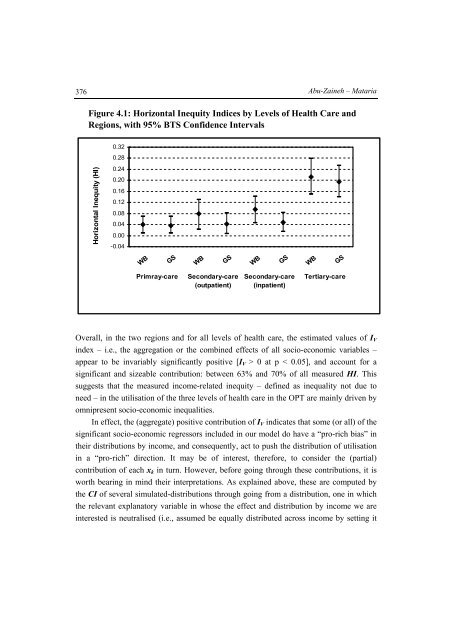The Palestinian Economy. Theoretical and Practical Challenges
The Palestinian Economy. Theoretical and Practical Challenges
The Palestinian Economy. Theoretical and Practical Challenges
Create successful ePaper yourself
Turn your PDF publications into a flip-book with our unique Google optimized e-Paper software.
376<br />
Abu-Zaineh – Mataria<br />
Figure 4.1: Horizontal Inequity Indices by Levels of Health Care <strong>and</strong><br />
Regions, with 95% BTS Confidence Intervals<br />
0.32<br />
0.28<br />
Horizontal Inequity (HI)<br />
0.24<br />
0.20<br />
0.16<br />
0.12<br />
0.08<br />
0.04<br />
0.00<br />
-0.04<br />
WB<br />
GS<br />
WB<br />
GS<br />
WB<br />
GS<br />
WB<br />
GS<br />
Primray-care<br />
Secondary-care<br />
(outpatient)<br />
Secondary-care<br />
(inpatient)<br />
Tertiary-care<br />
Overall, in the two regions <strong>and</strong> for all levels of health care, the estimated values of I V<br />
index – i.e., the aggregation or the combined effects of all socio-economic variables –<br />
appear to be invariably significantly positive [I V > 0 at p < 0.05], <strong>and</strong> account for a<br />
significant <strong>and</strong> sizeable contribution: between 63% <strong>and</strong> 70% of all measured HI. This<br />
suggests that the measured income-related inequity – defined as inequality not due to<br />
need – in the utilisation of the three levels of health care in the OPT are mainly driven by<br />
omnipresent socio-economic inequalities.<br />
In effect, the (aggregate) positive contribution of I V indicates that some (or all) of the<br />
significant socio-economic regressors included in our model do have a “pro-rich bias” in<br />
their distributions by income, <strong>and</strong> consequently, act to push the distribution of utilisation<br />
in a “pro-rich” direction. It may be of interest, therefore, to consider the (partial)<br />
contribution of each x k in turn. However, before going through these contributions, it is<br />
worth bearing in mind their interpretations. As explained above, these are computed by<br />
the CI of several simulated-distributions through going from a distribution, one in which<br />
the relevant explanatory variable in whose the effect <strong>and</strong> distribution by income we are<br />
interested is neutralised (i.e., assumed be equally distributed across income by setting it
















